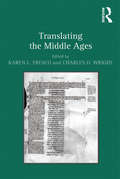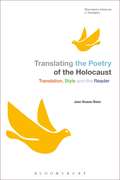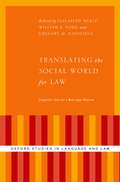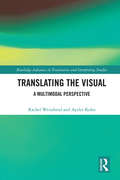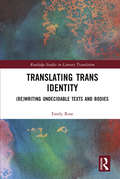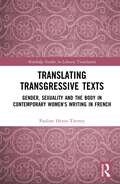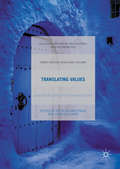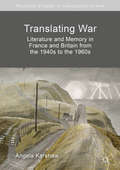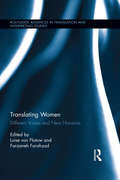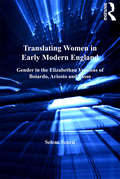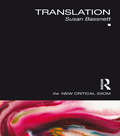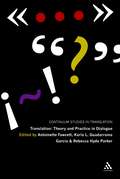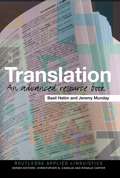- Table View
- List View
Translating the Middle Ages
by Karen L. FrescoDrawing on approaches from literary studies, history, linguistics, and art history, and ranging from Late Antiquity to the sixteenth century, this collection views 'translation' broadly as the adaptation and transmission of cultural inheritance. The essays explore translation in a variety of sources from manuscript to print culture and the creation of lexical databases. Several essays look at the practice of textual translation across languages, including the vernacularization of Latin literature in England, France, and Italy; the translation of Greek and Hebrew scientific terms into Arabic; and the use of Hebrew terms in anti-Jewish and anti-Muslim polemics. Other essays examine medieval translators' views and performance of translation, looking at Lydgate's translation of Greek myths through mental images rendered through rhetorical figures or at how printing transformed the rhetoric of intervernacular translation of chivalric romances. This collection also demonstrates translation as a key element in the construction of cultural and political identity in the Fet des Romains and Chester Whitsun Plays, and in the papacy's efforts to compete with Byzantium by controlling the translation of Greek writings.
Translating the Nonhuman: What Science Fiction Can Teach Us About Translating
by Professor Douglas RobinsonExtends the field of translation studies and theory by examining three radical science-fiction treatments of translation. The so-called "fictional turn" in translation studies has staked out territory previously unclaimed by translation scholars – territory in which translators are portrayed as full human beings in their social environments – but so far no one has looked to science fiction for truly radical explorations of translation. Translating the Nonhuman fills that gap, exploring speculative attempts to cross the yawning chasm between human and nonhuman languages and cultures.The book consists of three essays, each bringing a different theoretical orientation to bear on a different science-fiction work. The first studies Samuel R. Delany's 1966 novel, Babel-17, using Peircean semiotics; the second studies Suzette Haden Elgin's 1984 novel, Native Tongue, using Austinian performativity and Eve Sedwick's periperformative corrective; and the third studies Ted Chiang's 1998 novella, “Story of Your Life,” and its 2016 screen adaptation, Arrival, using sustainability theory. Themes include the 1950s clash between Whorfian untranslatability and the possibility of unbounded (machine) translatability; the performative ability of a language to change reality and the reliance of that ability on the periperformativity of “witnesses”; and alienation from the familiar in space and time and its transformative effect on the biological and cultural sustainability of human life on earth. Through these close readings and varied theoretical approaches, Translating the Nonhuman provides a tentative mapping of science fiction's usefulness for the study of human-(non)human translation, with translators and interpreters acting as explorers of new ways to communicate.
Translating the Poetry of the Holocaust: Translation, Style and the Reader (Bloomsbury Advances in Translation)
by Jean Boase-BeierTaking a cognitive approach, this book asks what poetry, and in particular Holocaust poetry, does to the reader - and to what extent the translation of this poetry can have the same effects. It is informed by current theoretical discussion and features many practical examples.Holocaust poetry differs from other genres of writing about the Holocaust in that it is not so much concerned to document facts as to document feelings and the sense of an experience. It shares the potential of all poetry to have profound effects on the thoughts and feelings of the reader.This book examines how the openness to engagement that Holocaust poetry can engender, achieved through stylistic means, needs to be preserved in translation if the translated poem is to function as a Holocaust poem in any meaningful sense. This is especially true when historical and cultural distance intervenes. The first book of its kind and by a world-renowned scholar and translator, this is required reading.
Translating the Poetry of the Holocaust: Translation, Style and the Reader (Bloomsbury Advances in Translation)
by Jean Boase-BeierTaking a cognitive approach, this book asks what poetry, and in particular Holocaust poetry, does to the reader - and to what extent the translation of this poetry can have the same effects. It is informed by current theoretical discussion and features many practical examples.Holocaust poetry differs from other genres of writing about the Holocaust in that it is not so much concerned to document facts as to document feelings and the sense of an experience. It shares the potential of all poetry to have profound effects on the thoughts and feelings of the reader.This book examines how the openness to engagement that Holocaust poetry can engender, achieved through stylistic means, needs to be preserved in translation if the translated poem is to function as a Holocaust poem in any meaningful sense. This is especially true when historical and cultural distance intervenes. The first book of its kind and by a world-renowned scholar and translator, this is required reading.
Translating the Social World for Law: Linguistic Tools for a New Legal Realism (Oxford Studies in Language and Law)
by Elizabeth Mertz William K. Ford Gregory MatoesianThis volume examines the linguistic problems that arise in efforts to translate between law and the social sciences. We usually think of "translation" as pertaining to situations involving distinct languages such as English and Swahili. But realistically, we also know that there are many kinds of English or Swahili, so that some form of translation may still be needed even between two people who both speak English-including, for example, between English speakers who are members of different professions. Law and the social sciences certainly qualify as disciplines with quite distinctive language patterns and practices, as well as different orientations and goals. In coordinated papers that are grounded in empirical research, the volume contributors use careful linguistic analysis to understand how attempts to translate between different disciplines can misfire in systematic ways. Some contributors also point the way toward more fruitful translation practices. The contributors to this volume are members of an interdisciplinary working group on Legal Translation that met for a number of years. The group includes scholars from law, philosophy, anthropology, linguistics, political science, psychology, and religious studies. The members of this group approach interdisciplinary communication as a form of "translation" between distinct disciplinary languages (or, "registers"). Although it may seem obvious that professionals in different fields speak and think differently about the world, in fact experts in law and in social science too often assume that they can communicate easily when they are speaking what appears to be the "same" language. While such experts may intellectually understand that they differ regarding their fundamental assumptions and uses of language, they may nonetheless consistently underestimate the degree to which they are actually talking past one another. This problem takes on real-life significance when one of the fields is law, where how knowledge is conveyed can affect how justice is meted out.
Translating the Visual: A Multimodal Perspective (Routledge Advances in Translation and Interpreting Studies)
by Rachel Weissbrod Ayelet KohnThis book offers insights into the translation and adaptation of illustrated texts in an era in which visual texts are perceived as a dominant perceptual frame for interpreting social and cultural phenomena. Using source texts including illustrated books, comics, graphic novels and animated films, the authors analyze their translations and adaptations to address the works as multimodal entities, in which even the replacement of one component affects the entire whole. Interviews with the artists - writers, illustrators and animators - will shed more light on the observations. This volume’s unique focus on the visual mode and the impact of its replacement on the multimodal whole is a topic that has not attracted as much attention as the translation of the verbal component, and will appeal to students and researchers of translation and adaptation, popular culture, media and communication, and children’s literature alike.
Translating the Visual: A Multimodal Perspective (Routledge Advances in Translation and Interpreting Studies)
by Rachel Weissbrod Ayelet KohnThis book offers insights into the translation and adaptation of illustrated texts in an era in which visual texts are perceived as a dominant perceptual frame for interpreting social and cultural phenomena. Using source texts including illustrated books, comics, graphic novels and animated films, the authors analyze their translations and adaptations to address the works as multimodal entities, in which even the replacement of one component affects the entire whole. Interviews with the artists - writers, illustrators and animators - will shed more light on the observations. This volume’s unique focus on the visual mode and the impact of its replacement on the multimodal whole is a topic that has not attracted as much attention as the translation of the verbal component, and will appeal to students and researchers of translation and adaptation, popular culture, media and communication, and children’s literature alike.
Translating Tourism: Cross-Linguistic Differences of Alternative Worldviews (Palgrave Studies in Translating and Interpreting)
by Sofia MalamatidouThis book provides a large-scale empirical multilingual study of crosslinguistic differences in the language of destination promotion. The book explores how tourism texts are negotiated in translation, and how the translated texts reflect and reconcile different worldviews, that of the destination population and that of the tourist. Using the 2-million-word TrAIL (Tourism Across and & In-between Languages) corpus, which includes examples from official tourism websites in English, French, Greek, and Russian as well as translations between these languages, the author explores the differences in the key linguistic means used in destination promotion and what these linguistic choices can tell us about how these societies view the world around them differently. The book’s interdisciplinary focus makes it relevant to not only practising translators, but also students and scholars interested in issues surrounding tourism, promotion, and translation, as well as destination promoters who want to better understand the role that language and translation play in tourism promotion.
Translating Trans Identity: (Re)Writing Undecidable Texts and Bodies (Routledge Studies in Literary Translation)
by Emily RoseThis book explores the ways in which translation deals with sexual and textual undecidability, adopting an interdisciplinary approach bridging translation, transgender studies, and queer studies in analyzing the translations of six texts in English, French, and Spanish labelled as ‘trans.’ Rose draws on experimental translation methods, such as the use of the palimpsest, and builds on theory from areas such as philosophy, linguistics, queer studies, and transgender studies and the work of such thinkers as Derrida and Deleuze to encourage critical thinking around how all texts and trans texts specifically work to be queer and how queerness in translation might be celebrated. These texts illustrate the ways in which their authors play language games and how these can be translated between languages that use gender in different ways and the subsequent implications for our understanding of the act of translation and how we present our gender identity or identities. In showing what translation and transgender identity can learn from one another, Rose lays the foundation for future directions for research into the translation of trans identity, making this book key reading for scholars in translation studies, transgender studies, and queer studies.
Translating Trans Identity: (Re)Writing Undecidable Texts and Bodies (Routledge Studies in Literary Translation)
by Emily RoseThis book explores the ways in which translation deals with sexual and textual undecidability, adopting an interdisciplinary approach bridging translation, transgender studies, and queer studies in analyzing the translations of six texts in English, French, and Spanish labelled as ‘trans.’ Rose draws on experimental translation methods, such as the use of the palimpsest, and builds on theory from areas such as philosophy, linguistics, queer studies, and transgender studies and the work of such thinkers as Derrida and Deleuze to encourage critical thinking around how all texts and trans texts specifically work to be queer and how queerness in translation might be celebrated. These texts illustrate the ways in which their authors play language games and how these can be translated between languages that use gender in different ways and the subsequent implications for our understanding of the act of translation and how we present our gender identity or identities. In showing what translation and transgender identity can learn from one another, Rose lays the foundation for future directions for research into the translation of trans identity, making this book key reading for scholars in translation studies, transgender studies, and queer studies.
Translating Transgressive Texts: Gender, Sexuality and the Body in Contemporary Women’s Writing in French (Routledge Studies in Literary Translation)
by Pauline Henry-TierneyThrough close examination of references to gender identity, female sexuality and corporeality, this book is the first of its kind to shed light on the complexities of translating the recent transgressive turn in contemporary women’s writing in French. Via four case studies, namely, the translations into English of Nelly Arcan’s Putain (2001), Catherine Millet’s La Vie sexuelle de Catherine M. (2001), Nancy Huston’s Infrarouge (2010) and Nina Bouraoui’s Garçon manqué (2000), this book explores how transgressive topoi such as prostitution, anorexia, matrophobia, rape, female desire, and transgenderism are translated. The book considers how (auto)fictional female selves portrayed are dis/placed by translation at both a textual and paratextual level. Combining feminist phenomenological perspectives on female lived experience with feminist translation theory, this interdisciplinary study offers an insight into how the experiential is brought into language, how it journeys via language into new cultural contexts via translation and creates a dialogical space in which the subjectivities of those involved (author, narrator, protagonist, translator) become open to the porosity of encounters with alterity. The volume will appeal to scholars in translation studies, French Studies, and gender and sexuality studies, particularly those interested in feminist translation and literary translation.
Translating Transgressive Texts: Gender, Sexuality and the Body in Contemporary Women’s Writing in French (Routledge Studies in Literary Translation)
by Pauline Henry-TierneyThrough close examination of references to gender identity, female sexuality and corporeality, this book is the first of its kind to shed light on the complexities of translating the recent transgressive turn in contemporary women’s writing in French. Via four case studies, namely, the translations into English of Nelly Arcan’s Putain (2001), Catherine Millet’s La Vie sexuelle de Catherine M. (2001), Nancy Huston’s Infrarouge (2010) and Nina Bouraoui’s Garçon manqué (2000), this book explores how transgressive topoi such as prostitution, anorexia, matrophobia, rape, female desire, and transgenderism are translated. The book considers how (auto)fictional female selves portrayed are dis/placed by translation at both a textual and paratextual level. Combining feminist phenomenological perspectives on female lived experience with feminist translation theory, this interdisciplinary study offers an insight into how the experiential is brought into language, how it journeys via language into new cultural contexts via translation and creates a dialogical space in which the subjectivities of those involved (author, narrator, protagonist, translator) become open to the porosity of encounters with alterity. The volume will appeal to scholars in translation studies, French Studies, and gender and sexuality studies, particularly those interested in feminist translation and literary translation.
Translating Values: Evaluative Concepts in Translation (Palgrave Studies in Translating and Interpreting)
by John Gillespie Piotr BlumczynskiThis collection explores the central importance of values and evaluative concepts in cross-cultural translational encounters. Written by a group of international scholars from a diverse range of linguistic and cultural backgrounds, the chapters in this book consider what it means to translate cultures by examining core values and their relationship to key evaluative concepts (such as authenticity, clarity, home, honour, or justice) and how they influence the complex multidimensional process of translation. This book will be of interest to academics studying cross-cultural and inter-linguistic interactions, to translators and interpreters, students of translation and of modern languages, and all those dealing with multilingual and multicultural settings.
Translating War: Literature and Memory in France and Britain from the 1940s to the 1960s (Palgrave Studies in Languages at War)
by Angela KershawThis book examines the role played by the international circulation of literature in constructing cultural memories of the Second World War. War writing has rarely been read from the point of view of translation even though war is by definition a multilingual event, and knowledge of the Second World War and the Holocaust is mediated through translated texts. Here, the author opens up this field of research through analysis of several important works of French war fiction and their English translations. The book examines the wartime publishing structures which facilitated literary exchanges across national borders, the strategies adopted by translators of war fiction, the relationships between translated war fiction and dominant national memories of the war, and questions of multilingualism in war writing. In doing so, it sheds new light on the political and ethical questions that arise when the trauma of war is represented in fiction and through translation. This engaging work will appeal to students and scholars of translation, cultural memory, war fiction and Holocaust writing.
Translating Warhol (Literatures, Cultures, Translation)
by Reva WolfThe first study of the translations of Andy Warhol's writing and ideas, Translating Warhol reveals how translation has alternately censored, exposed, or otherwise affected the presentation of his political and social positions and attitudes and, in turn, the value we place on his art and person.Andy Warhol is one of the most influential artists of the 20th century, and a vast global literature about Warhol and his work exists. Yet almost nothing has been written about the role of translations of his words in his international reputation. Translating Warhol fills this gap, developing the topic in multiple directions and in the context of the reception of Warhol's work in various countries. The numerous translations of Warhol's writings, words, and ideas offer a fertile case study of how American art was, and is, viewed from the outside. Both historical and theoretical aspects of translation are taken up, and individual chapters discuss French, German, Italian, and Swedish translations, Warhol's translations of his mother's native Rusyn language and culture, the Indian artist Bhupen Khakhar's performative translations of Warhol, and Warhol as translated for documentary television.Translating Warhol offers a fascinating multi-faceted perspective on Warhol, contributing to our understanding of his place in history as well as to translation theory and inter-cultural exchange.
Translating Warhol (Literatures, Cultures, Translation)
The first study of the translations of Andy Warhol's writing and ideas, Translating Warhol reveals how translation has alternately censored, exposed, or otherwise affected the presentation of his political and social positions and attitudes and, in turn, the value we place on his art and person.Andy Warhol is one of the most influential artists of the 20th century, and a vast global literature about Warhol and his work exists. Yet almost nothing has been written about the role of translations of his words in his international reputation. Translating Warhol fills this gap, developing the topic in multiple directions and in the context of the reception of Warhol's work in various countries. The numerous translations of Warhol's writings, words, and ideas offer a fertile case study of how American art was, and is, viewed from the outside. Both historical and theoretical aspects of translation are taken up, and individual chapters discuss French, German, Italian, and Swedish translations, Warhol's translations of his mother's native Rusyn language and culture, the Indian artist Bhupen Khakhar's performative translations of Warhol, and Warhol as translated for documentary television.Translating Warhol offers a fascinating multi-faceted perspective on Warhol, contributing to our understanding of his place in history as well as to translation theory and inter-cultural exchange.
Translating Women: Different Voices and New Horizons (Routledge Advances in Translation and Interpreting Studies)
by Luise Von Flotow Farzaneh FarahzadThis book focuses on women and translation in cultures 'across other horizons' well beyond the European or Anglo-American centres. Drawing on transnational feminist connections, its editors have assembled work from four continents and included articles from Morocco, Mexico, Sri Lanka, Turkey, China, Saudi Arabia, Columbia and beyond. Thirteen different chapters explore questions around women's roles in translation: as authors, or translators, or theoreticians. In doing so, they open new territories for studies in the area of 'gender and translation' and stimulate academic work on questions in this field around the world. The articles examine the impact of 'Western' feminism when translated to other cultures; they describe translation projects devised to import and make meaningful feminist texts from other places; they engage with the politics of publishing translations by women authors in other cultures, and the role of women translators play in developing new ideas. The diverse approaches to questions around women and translation developed in this collection speak to the volume of unexplored material that has yet to be addressed in this field.
Translating Women: Different Voices and New Horizons (Routledge Advances in Translation and Interpreting Studies)
by Luise Von Flotow Farzaneh FarahzadThis book focuses on women and translation in cultures 'across other horizons' well beyond the European or Anglo-American centres. Drawing on transnational feminist connections, its editors have assembled work from four continents and included articles from Morocco, Mexico, Sri Lanka, Turkey, China, Saudi Arabia, Columbia and beyond. Thirteen different chapters explore questions around women's roles in translation: as authors, or translators, or theoreticians. In doing so, they open new territories for studies in the area of 'gender and translation' and stimulate academic work on questions in this field around the world. The articles examine the impact of 'Western' feminism when translated to other cultures; they describe translation projects devised to import and make meaningful feminist texts from other places; they engage with the politics of publishing translations by women authors in other cultures, and the role of women translators play in developing new ideas. The diverse approaches to questions around women and translation developed in this collection speak to the volume of unexplored material that has yet to be addressed in this field.
Translating Women in Early Modern England: Gender in the Elizabethan Versions of Boiardo, Ariosto and Tasso (Anglo-Italian Renaissance Studies)
by Selene ScarsiSituating itself in a long tradition of studies of Anglo-Italian literary relations in the Renaissance, this book consists of an analysis of the representation of women in the extant Elizabethan translations of the three major Italian Renaissance epic poems (Matteo Maria Boiardo's Orlando Innamorato, Ludovico Ariosto's Orlando Furioso and Torquato Tasso's Gerusalemme Liberata), as well as of the influence of these works on Elizabethan Literature in general, in the form of creative imitation on the part of poets such as Edmund Spenser, Peter Beverley, William Shakespeare and Samuel Daniel, and of prose writers such as George Whetstone and George Gascoigne. The study emphasises the importance of European writers' influence on English Renaissance Literature and raises questions pertaining to the true essence of translation, adaptation and creative imitation, with a specific emphasis on gender issues. Its originality lies in its exhaustiveness, as well as in its focus on the epics' female figures, both as a source of major modifications and as an evident point of interest for the Italian works' 'translatorship'.
Translating Women in Early Modern England: Gender in the Elizabethan Versions of Boiardo, Ariosto and Tasso (Anglo-Italian Renaissance Studies)
by Selene ScarsiSituating itself in a long tradition of studies of Anglo-Italian literary relations in the Renaissance, this book consists of an analysis of the representation of women in the extant Elizabethan translations of the three major Italian Renaissance epic poems (Matteo Maria Boiardo's Orlando Innamorato, Ludovico Ariosto's Orlando Furioso and Torquato Tasso's Gerusalemme Liberata), as well as of the influence of these works on Elizabethan Literature in general, in the form of creative imitation on the part of poets such as Edmund Spenser, Peter Beverley, William Shakespeare and Samuel Daniel, and of prose writers such as George Whetstone and George Gascoigne. The study emphasises the importance of European writers' influence on English Renaissance Literature and raises questions pertaining to the true essence of translation, adaptation and creative imitation, with a specific emphasis on gender issues. Its originality lies in its exhaustiveness, as well as in its focus on the epics' female figures, both as a source of major modifications and as an evident point of interest for the Italian works' 'translatorship'.
Translation (The New Critical Idiom)
by Susan BassnettIn a time when millions travel around the planet; some by choice, some driven by economic or political exile, translation of the written and spoken word is of ever increasing importance. This guide presents readers with an accessible and engaging introduction to the valuable position translation holds within literature and society. Leading translation theorist, Susan Bassnett traces the history of translation, examining the ways translation is currently utilised as a burgeoning interdisciplinary activity and considers more recent research into developing technologies and new media forms. Translation displays the importance of translation across disciplines, and is essential reading for students and scholars of translation, literary studies, globalisation studies, and ancient and modern languages.
Translation (The New Critical Idiom)
by Susan BassnettIn a time when millions travel around the planet; some by choice, some driven by economic or political exile, translation of the written and spoken word is of ever increasing importance. This guide presents readers with an accessible and engaging introduction to the valuable position translation holds within literature and society. Leading translation theorist, Susan Bassnett traces the history of translation, examining the ways translation is currently utilised as a burgeoning interdisciplinary activity and considers more recent research into developing technologies and new media forms. Translation displays the importance of translation across disciplines, and is essential reading for students and scholars of translation, literary studies, globalisation studies, and ancient and modern languages.
Translation: A Guide To The Practice Of Crafting Target Texts
by Stella Cragie Ann PattisonThis practical guide by two experienced translators and translation tutors explores aspects of time, context and culture in a range of translated literary texts, including novels, memoirs, poems and plays. Reflective analytical sections are complemented by a variety of practical tasks that reflect the book’s craft-based approach. Providing a dual focus on both analysis and creativity, this volume helps readers to develop two different skill sets required for translation: deconstruction and reconstruction. To learn how to analyse or deconstruct a source text (ST), the tasks include translating and editing, comparison and analysis of source language (SL) texts and translations, and critiquing or improving target language (TL) texts produced by translators from different times. A range of creative writing challenges reveal the secrets writers use to hook their readers. Whatever language readers translate into, these insights will help them to find their own writer’s voice, making them better equipped to recreate another author’s voice, whatever the time or cultural context. This is the essential guide to improving target texts for all translators and students of translation.
Translation: Translation: Theory And Practice In Dialogue (Continuum Studies in Translation)
by Antoinette Fawcett Karla L. Guadarrama García Rebecca Hyde ParkerThis exciting new book explores the present relevance of translation theory to practice. A range of perspectives provides both current theoretical insights into the relevance of theory to translation and also offers first-hand experiences of applying appropriate strategies and methods to the practice and description of translation. The individual chapters in the book explore theoretical pronouncements and practical observations grouped in topics that include theory and creativity, translation and its relation with linguistics, gender issues and more. The book features four parts: it firstly deals with how theories from both within translation studies and from other disciplines can contribute to our understanding of the practice of translation; secondly, how theory can be reconceptualized from examining translation in practice; thirdly reconceptualizing practice from theory; and finally Eastern European and Asian perspectives of how translation theory and practice inform one another. The chapters all show examples from theoretical and practical as well as pedagogical issues ensuring appeal for a wide readership. This book will appeal to advanced level students, researchers and academics in translation studies.
Translation: An Advanced Resource Book (PDF)
by Basil Hatim Jeremy MundayRoutledge Applied Linguistics is a series of comprehensive textbooks, providing students and researchers with the support they need for advanced study in the core areas of English language and Applied Linguistics. Each book in the series guides readers through three main sections, enabling them to explore and develop major themes within the discipline. Section A, Introduction, establishes the key terms and concepts and extends readers’ techniques of analysis through practical application. Section B, Extension, brings together influential articles, sets them in context, and discusses their contribution to the field. Section C, Exploration, builds on knowledge gained in the first two sections, setting thoughtful tasks around further illustrative material. This enables readers to engage more actively with the subject matter and encourages them to develop their own research responses. Throughout the book, topics are revisited, extended, interwoven and deconstructed, with the reader’s understanding strengthened by tasks and follow-up questions. Translation: examines the theory and practice of translation from a variety of linguistic and cultural angles, including semantics, functional linguistics, corpus and cognitive linguistics, discourse analysis, gender studies and postcolonialism draws on a wide range of languages, including French, Spanish, German, Italian, Russian and Arabic explores material from a variety of sources, such as the Internet, advertisements, religious texts, literary and technical texts gathers together influential readings from the key names in the discipline, including James S. Holmes, George Steiner, Vinay and Darbelnet, Eugene Nida, Werner Koller and Ernst-August Gutt. Written by experienced teachers and researchers in the field, Translation: An Advanced Resource Book is an essential textbook for students and researchers of English language and Applied Linguistics. The accompanying website to this book can be found at http://www.routledge.com/textbooks/041528306X
